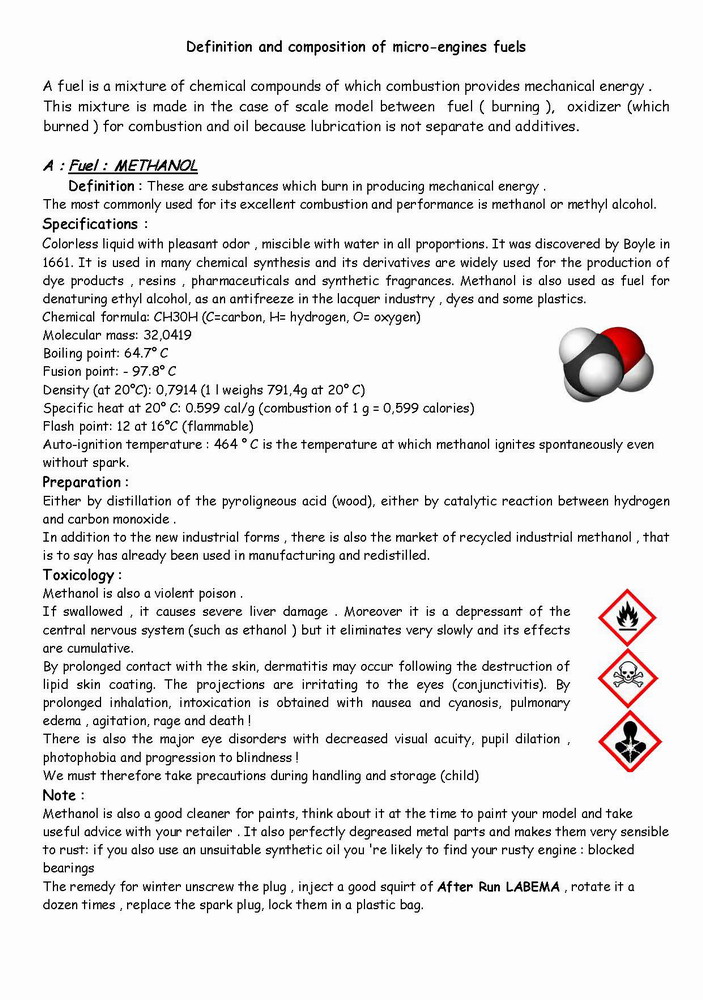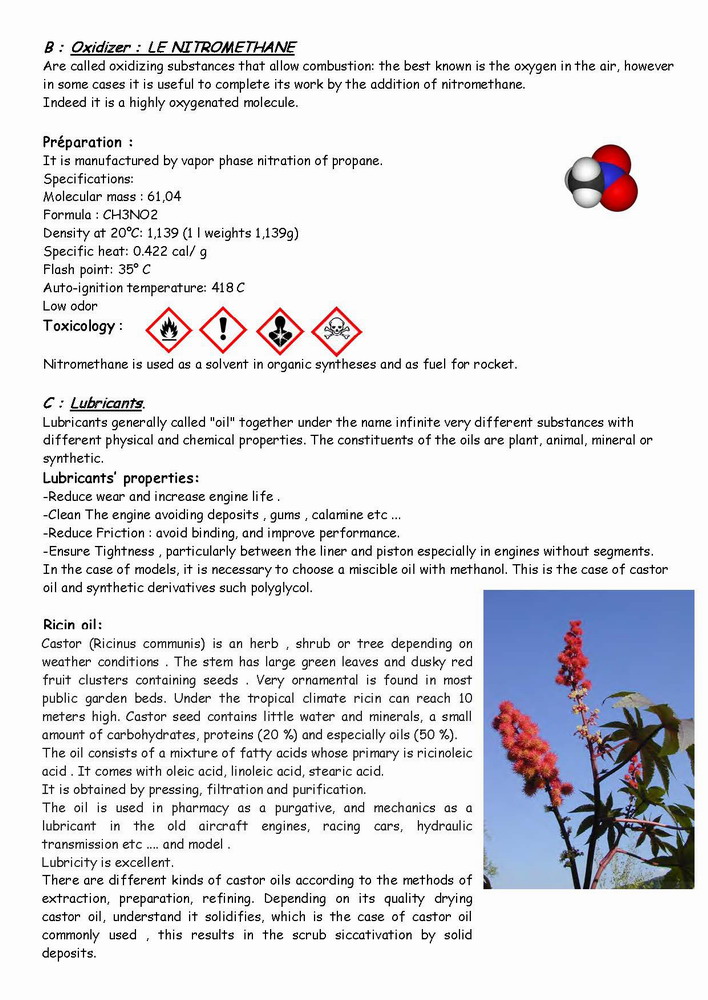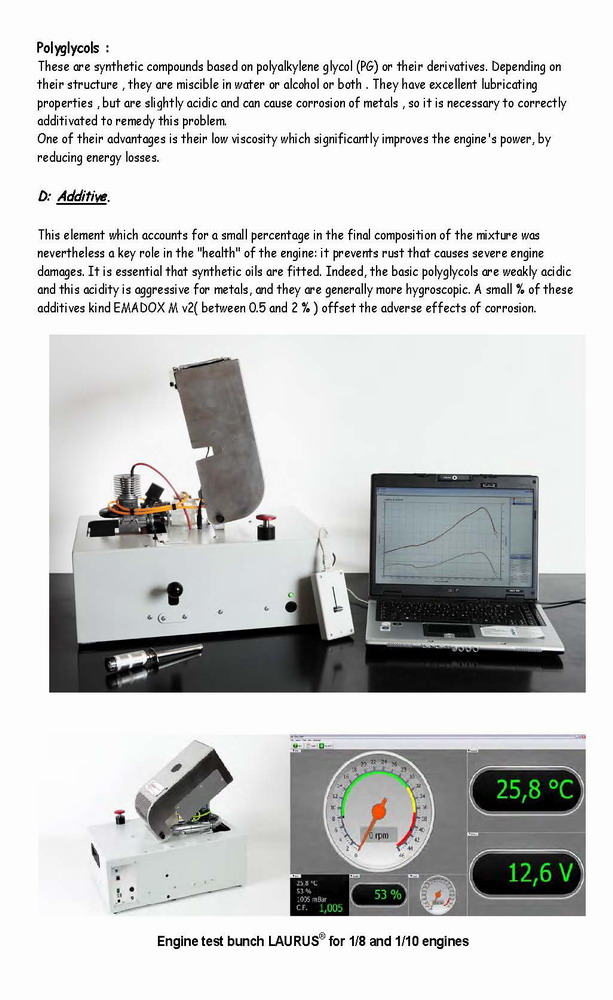


efinition and composition of micro-engines fuels
A fuel is a mixture of chemical compounds of which combustion provides mechanical energy .
This mixture is made in the case of scale model between fuel ( burning ), oxidizer (which burned ) for combustion and oil because lubrication is not separate and additives.
A : Fuel : METHANOL
Definition : These are substances which burn in producing mechanical energy .
The most commonly used for its excellent combustion and performance is methanol or methyl alcohol.
Specifications :
Colorless liquid with pleasant odor , miscible with water in all proportions. It was discovered by Boyle in 1661. It is used in many chemical synthesis and its derivatives are widely used for the production of dye products , resins , pharmaceuticals and synthetic fragrances. Methanol is also used as fuel for denaturing ethyl alcohol, as an antifreeze in the lacquer industry , dyes and some plastics.
Chemical formula: CH30H (C=carbon, H= hydrogen, O= oxygen)
Molecular mass: 32,0419
Boiling point: 64.7° C
Fusion point: – 97.8° C
Density (at 20°C): 0,7914 (1 l weighs 791,4g at 20° C)
Specific heat at 20° C: 0.599 cal/g (combustion of 1 g = 0,599 calories)
Flash point: 12 at 16°C (flammable)
Auto-ignition temperature : 464 ° C is the temperature at which methanol ignites spontaneously even without spark.
Preparation :
Either by distillation of the pyroligneous acid (wood), either by catalytic reaction between hydrogen and carbon monoxide .
In addition to the new industrial forms , there is also the market of recycled industrial methanol , that is to say has already been used in manufacturing and redistilled.
Toxicology :
Methanol is also a violent poison .
If swallowed , it causes severe liver damage . Moreover it is a depressant of the central nervous system (such as ethanol ) but it eliminates very slowly and its effects are cumulative.
By prolonged contact with the skin, dermatitis may occur following the destruction of lipid skin coating. The projections are irritating to the eyes (conjunctivitis). By prolonged inhalation, intoxication is obtained with nausea and cyanosis, pulmonary edema , agitation, rage and death !
There is also the major eye disorders with decreased visual acuity, pupil dilation , photophobia and progression to blindness !
We must therefore take precautions during handling and storage (child)
Note :
Methanol is also a good cleaner for paints, think about it at the time to paint your model and take useful advice with your retailer . It also perfectly degreased metal parts and makes them very sensible to rust: if you also use an unsuitable synthetic oil you ‘re likely to find your rusty engine : blocked bearings
The remedy for winter unscrew the plug , inject a good squirt of After Run LABEMA , rotate it a dozen times , replace the spark plug, lock them in a plastic bag.
B : Oxidizer : LE NITROMETHANE
Are called oxidizing substances that allow combustion: the best known is the oxygen in the air, however in some cases it is useful to complete its work by the addition of nitromethane.
Indeed it is a highly oxygenated molecule.
Préparation :
It is manufactured by vapor phase nitration of propane.
Specifications:
Molecular mass : 61,04
Formula : CH3NO2
Density at 20°C: 1,139 (1 l weights 1,139g)
Specific heat: 0.422 cal/ g
Flash point: 35° C
Auto-ignition temperature: 418 C
Low odor
Toxicology :
Nitromethane is used as a solvent in organic syntheses and as fuel for rocket.
C : Lubricants.
Lubricants generally called “oil” together under the name infinite very different substances with different physical and chemical properties. The constituents of the oils are plant, animal, mineral or synthetic.
Lubricants’ properties:
-Reduce wear and increase engine life .
-Clean The engine avoiding deposits , gums , calamine etc …
-Reduce Friction : avoid binding, and improve performance.
-Ensure Tightness , particularly between the liner and piston especially in engines without segments.
In the case of models, it is necessary to choose a miscible oil with methanol. This is the case of castor oil and synthetic derivatives such polyglycol.
Castor (Ricinus communis) is an herb , shrub or tree depending on weather conditions . The stem has large green leaves and dusky red fruit clusters containing seeds . Very ornamental is found in most public garden beds. Under the tropical climate ricin can reach 10 meters high. Castor seed contains little water and minerals, a small amount of carbohydrates, proteins (20 %) and especially oils (50 %).
The oil consists of a mixture of fatty acids whose primary is ricinoleic acid . It comes with oleic acid, linoleic acid, stearic acid.
It is obtained by pressing, filtration and purification.
The oil is used in pharmacy as a purgative, and mechanics as a lubricant in the old aircraft engines, racing cars, hydraulic transmission etc …. and model .
Lubricity is excellent.
There are different kinds of castor oils according to the methods of extraction, preparation, refining. Depending on its quality drying castor oil, understand it solidifies, which is the case of castor oil commonly used , this results in the scrub siccativation by solid deposits.
Polyglycols :
These are synthetic compounds based on polyalkylene glycol (PG) or their derivatives. Depending on their structure , they are miscible in water or alcohol or both . They have excellent lubricating properties , but are slightly acidic and can cause corrosion of metals , so it is necessary to correctly additivated to remedy this problem.
One of their advantages is their low viscosity which significantly improves the engine’s power, by reducing energy losses.
D: Additive.
This element which accounts for a small percentage in the final composition of the mixture was nevertheless a key role in the “health” of the engine: it prevents rust that causes severe engine damages. It is essential that synthetic oils are fitted. Indeed, the basic polyglycols are weakly acidic and this acidity is aggressive for metals, and they are generally more hygroscopic. A small % of these additives kind EMADOX M v2( between 0.5 and 2 % ) offset the adverse effects of corrosion.